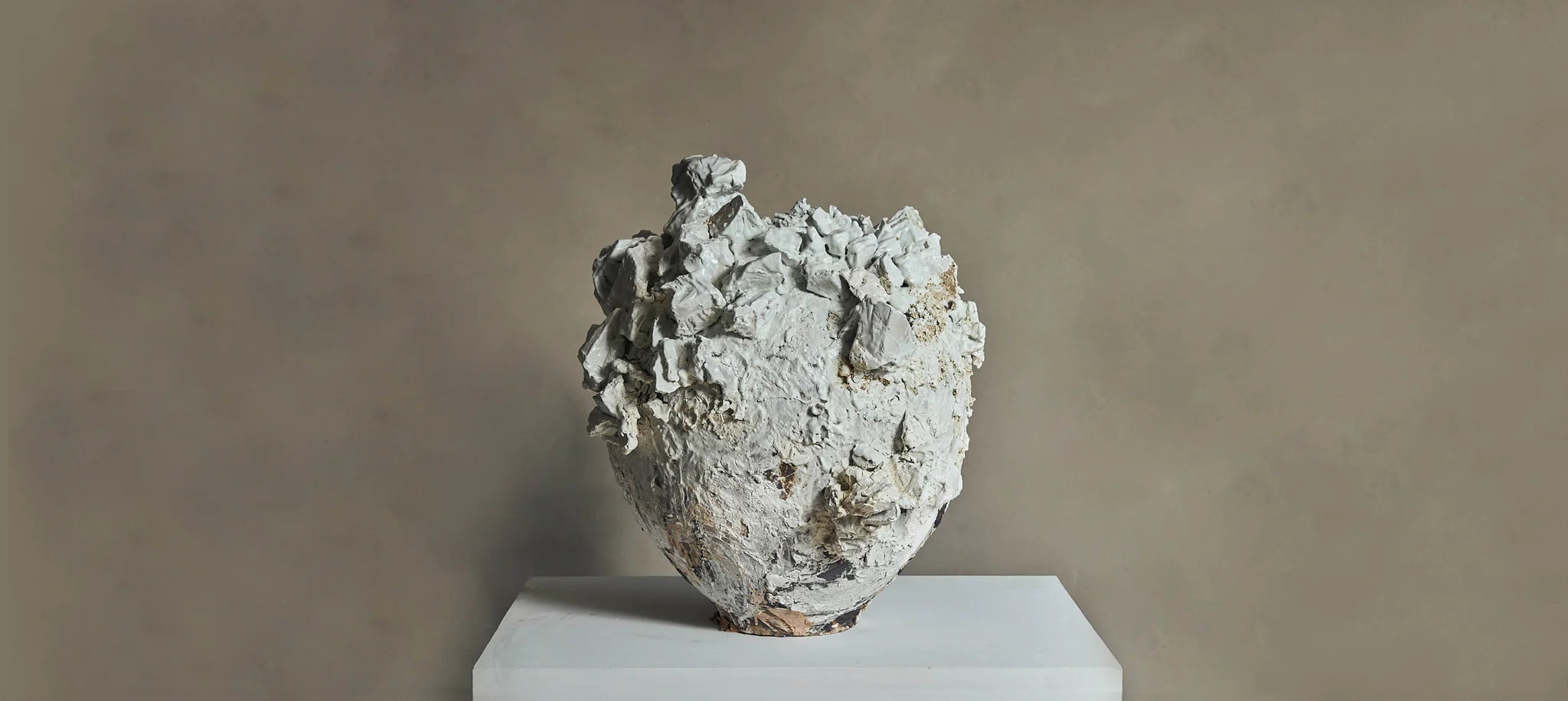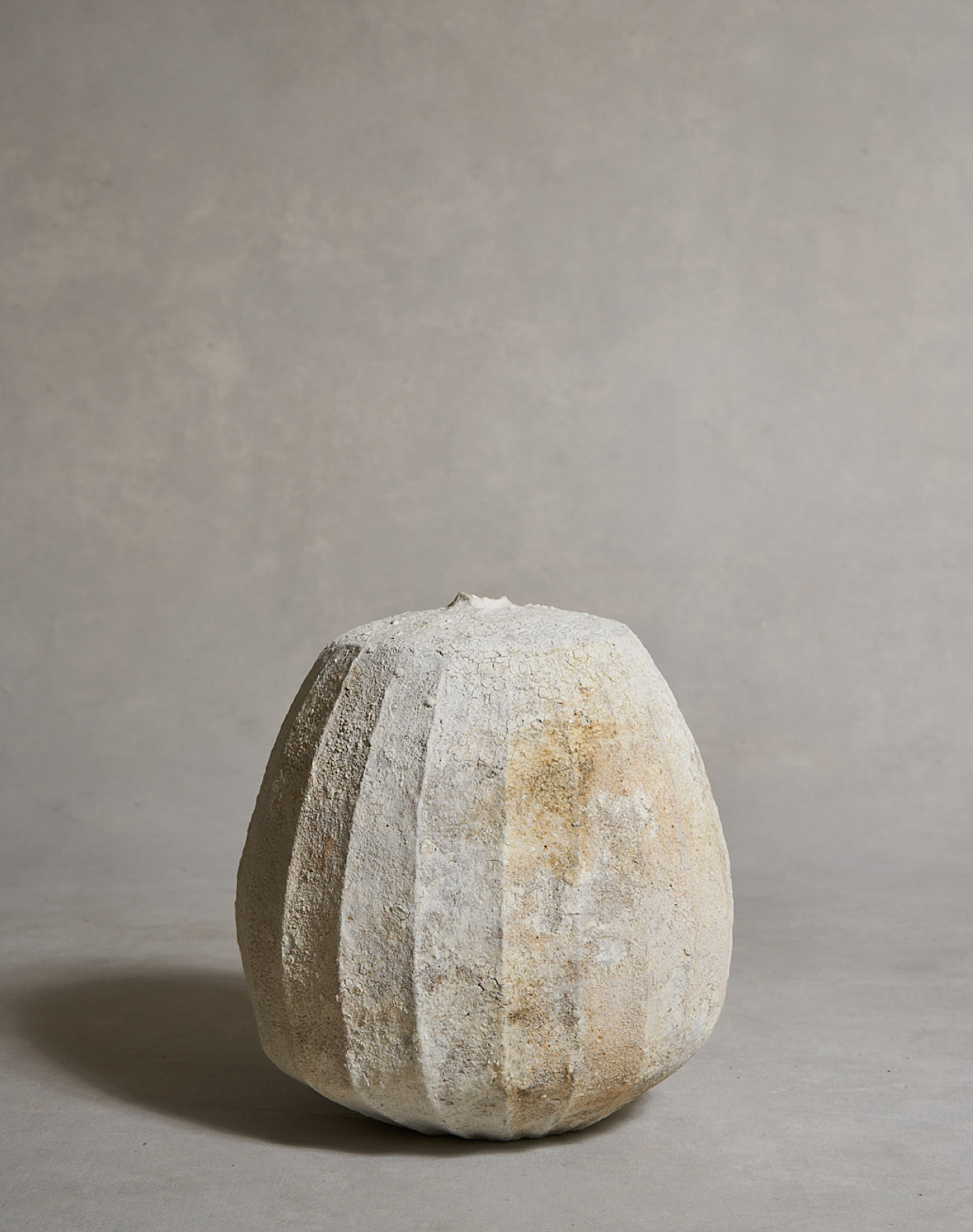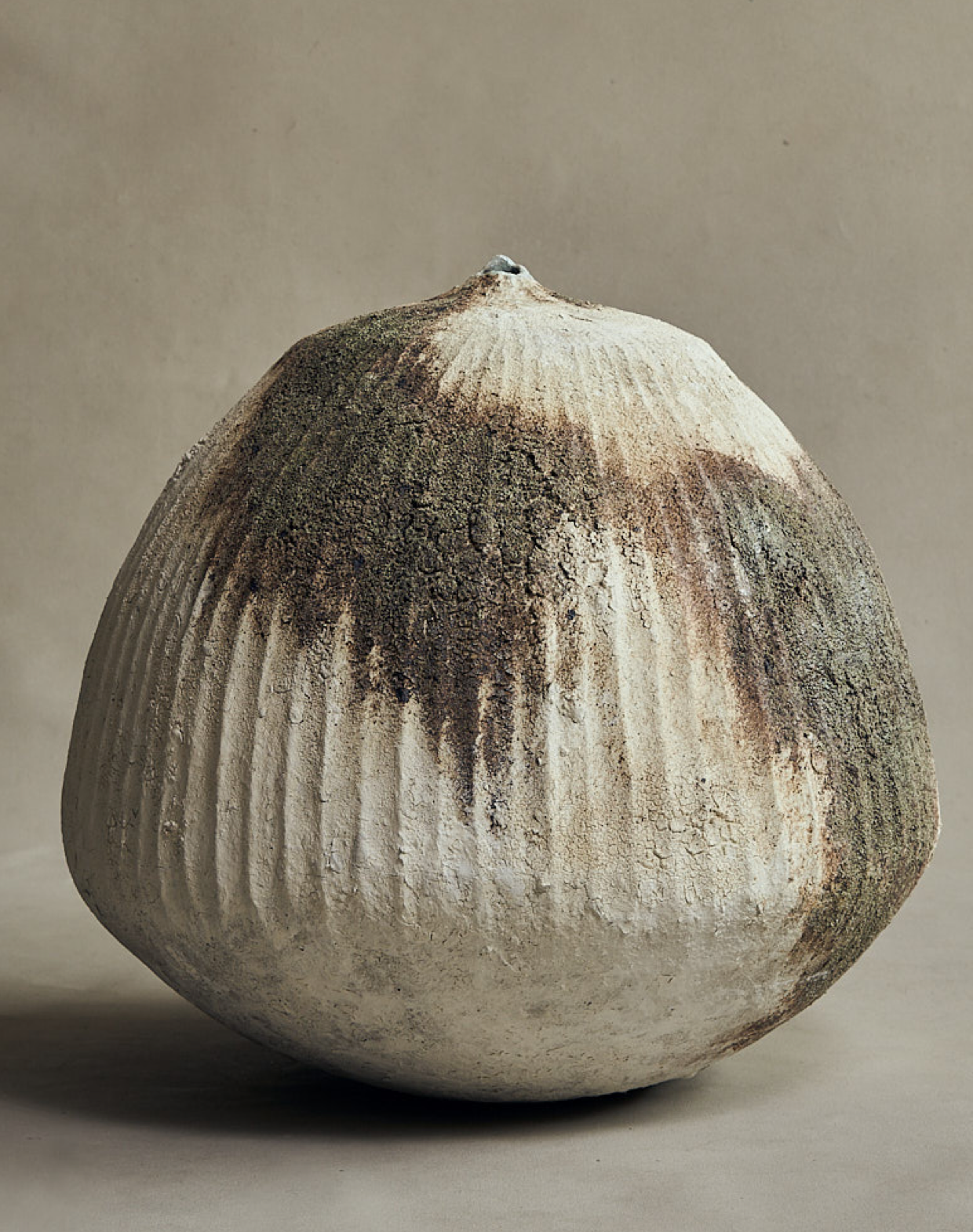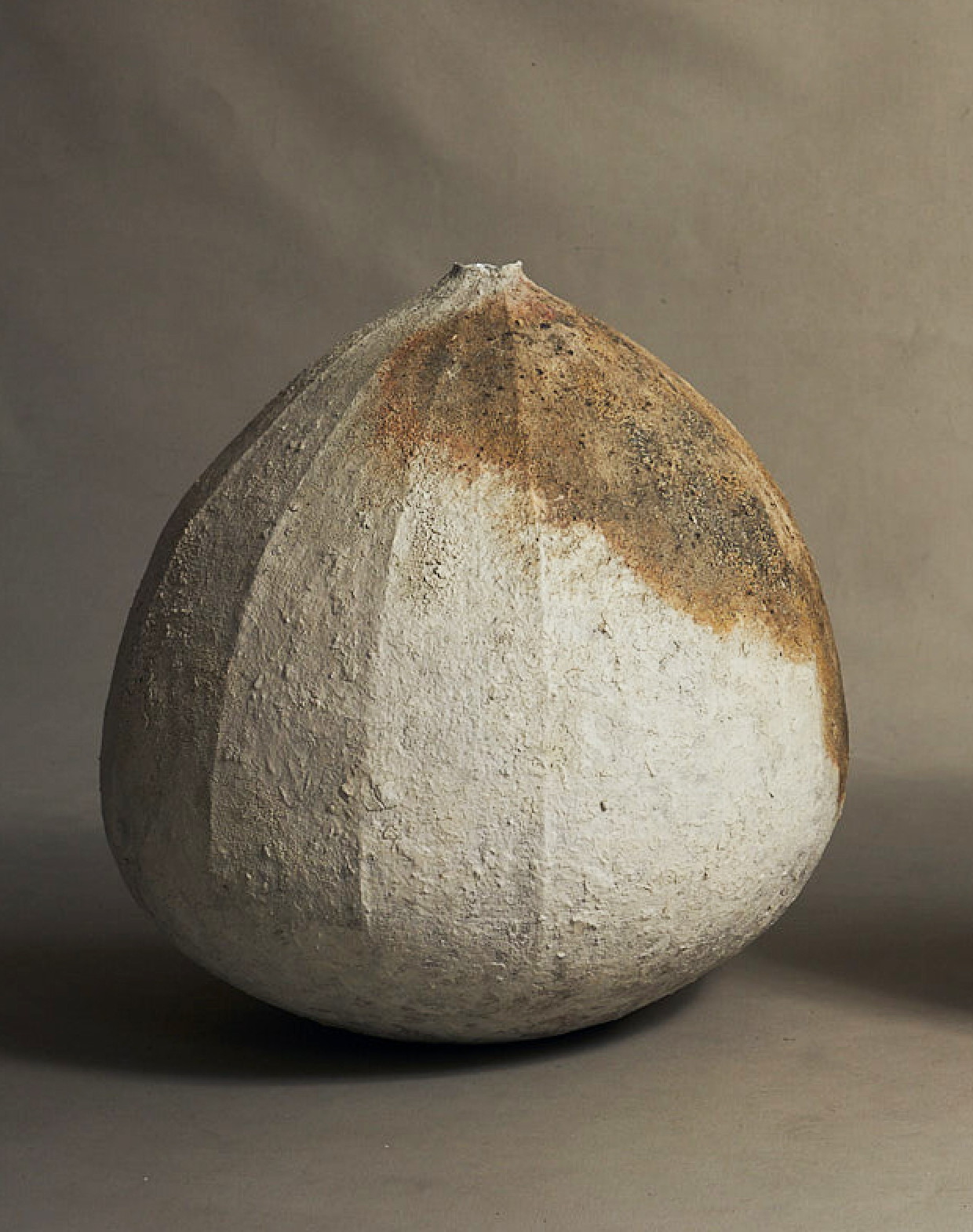AKIKO HIRAI
CONTAINER AND CONTENT
THREE TWO ONE CANAL STREET
NEW YORK, NY 10013
INFO@RWGUILDGALLERYNY.COM
646 693 0279
PRESS RELEASE
Installation
Works
Untitled Moon Jar
2021
Stoneware, porcelain slip, paper fiber, wood ash and white glaze
11"H x 10"D
AHMJ117
Untitled Moon Jar
2021
Stoneware, porcelain slip, paper fiber, wood ash and white glaze
H10" x D10.5"
AHMJ119
Untitled Poppy Pod
2021
Stoneware, porcelain slip, transparent glaze and wood ash
H10.5" x D10.5"
AHPP417
Untitled Poppy Pod
2021
Stoneware, porcelain slip, transparent glaze and wood ash
H13" x D13"
AHPP46
Untitled Poppy Pod
2021
Stoneware, porcelain slip, transparent glaze and wood ash
H19.5" x D23"
AHPP51
Untitled Poppy Pod
2021
Stoneware, porcelain slip, transparent glaze and wood ash
15"H x D21"
AHPP53
Untitled Poppy Pod
2021
Stoneware, porcelain slip, transparent glaze and wood ash
H24.5" x D20.4
AHPP61
About the Show
Words by novelist Christine Coulson
Can we hold a place? cup a landscape in our hands and feel the very stuff of it?
Akiko Hirai’s Poppy Pods swell with a force that feels like it might actually burst the hard, cracked surface of each vessel. It is the potential of an ancient seed. The energy of a still-tight bloom. The thing that will beget the next thing and the thing after that and the thing after that, until what stretches before us is no less than everything our eye can grasp. Every leaf and branch and patch of dirt. Every thing that crawls and grows from the smallest bud to the mightiest mountain. Every. Thing. Contained in this one elegant form, promising no less than the whole world.If the pod form holds life, Hirai’s Moon Jars seem to trace life’s accretions and ravages. These vessels sit in some eternal in-between, not fully developed, not completely broken. They tumble with memory: traces of movement, smudges of color, the lumps and scrapes of the artist’s making, the clay’s folding, the fire’s heat. Their surfaces writhe with energy, graffitied with a kind of three-dimensional writing, like the cratered scars of a wound or the deep creases of ordinary age. They feel excavated. Found. Ghosts that pulse with impermanence—shifting, building, dissolving into the quiet stillness of something freshly, silently, remembered.

AKIKO HIRAI USES A HAND COILING METHOD TO BUILD HER POPPY PODS
There are two different measurements in aesthetics that we commonly use: one is absolute and the other is relative. Absolute measurements see things as complete in their own right, while relative measurements see things in relation to their environment. Sometimes they show opposite connotations or are ambivalent, yet both are correct within their context. In absolute measurements, containers can exist without contents, but in relative measurements they cannot. In this exhibition I have made two types of containers: one withholds and the other releases its contents. The initial request was to make vases, so basically both types of object are supposed to be real containers. In fact, I often put tree branches in my Moon jars. However, my intention was also to make abstract containers and contents, so that they are slightly impractical.

"UNTITLED", 2021, STONEWARE, PORCELAIN SLIP, TRANSPARENT GLAZE AND WOOD ASH, 15 H X 21 DIA IN
“I LIKE HOW TIME CHANGES OBJECTS; THAT IMPERFECTION MAKES THE POT EVEN MORE BEAUTIFUL.”
– AKIKO HIRAI
ARTIST STATEMENT
I make pots that are slightly off. I make pots that have broken rims. They have crooked lines, irregularities and asymmetry, but i do not call these imperfections. There are two different measurements in aesthetics that we commonly use: one is absolute and the other is relative. Absolute measurements see things as complete in their own right, while relative measurements see things in relation to their environment. Sometimes they show opposite connotations or are ambivalent, yet both are correct within their context. In absolute measurements, containers can exist without contents, but in relative measurements they cannot. In this exhibition I have made two types of containers: one withholds and the other releases its contents. The initial request was to make vases, so basically both types of object are supposed to be real containers. In fact, I often put tree branches in my Moon jars. However, my intention was also to make abstract containers and contents, so that they are slightly impractical.
THE PODS
The word “pod” is a kind of onomatopoeia. The pod pops, the seeds pop out, fall in a flowerpot, the seeds sprout, grow back into a pod, packed full of seeds again. There is a japanese expression ポーン pronounced a bit like “pawn”. This phrase is used when something round, like a ball, bounces and jumps into the air. It begins with “po”. We need to use our mouth instantaneously in order to pronounce the “p” sound: the word has to pop out. Pods are also protective containers - over time they weather and discolour while the contents remain intact. You touch and feel these weathered shelters, and something is growing inside, but maybe it is growing only inside your mind. Kabuki actors who play female roles are often said to look more feminine than real women. This is because they are idealised women in a male actor’s imagination. Our imagination subsidises what we cannot see and creates something more than is actually there. That something may not even exist, proving concealment is a good trick for creating something beautiful. All you have to do is create abstract trigger points, certain types of texture, density, or outline.

"UNTITLED", 2021, STONEWARE, PORCELAIN SLIP, TRANSPARENT GLAZE AND WOOD ASH, 15 H X 21 DIA IN

"UNTITLED", 2021, STONEWARE, PORCELAIN SLIP, TRANSPARENT GLAZE AND WOOD ASH, 15 H X 21 DIA IN
THE MOONThe word “moon” is a mellow word. fifteen days to wax and fifteen days to wane. the moon does not bounce, even though it is round. there is so much slowness in the word “moon”, you have to close your mouth to pronounce the “m”. “moon” is holding the word in your mouth.The moon in japanese is 月, pronounced “tsuki”. it is said that it comes from つぐ pronounced “tsugu” meaning “to connect and continue” and 尽く pronounced“tsuku” meaning “to be ended” or “to become empty”: it comes from the combination of these word, wax and wane. the word itself does not have a circular sound, yet the meaning forms a circler shape. the moon waxes and wanes endlessly. it is both infinite and enclosed.My moon originates from the antique korean moon jar in a collection at the british museum in london: it has iron speckles, either from a lack of clay purifying technology, or because during the firing clean fuel was not available. there are some water stains from the pin holes on the glaze, and a small chip on the rim. there is a joining mark, as it is made from two porcelain pieces: porcelain does not like joints. again, i don’t call these imperfections. there are always good reasons why things happen, and events may leave marks on an object, but that does not mean the object is damaged.these marks can be very pleasant, it all depends on how you look at it. my moon has become more extreme over the years. everyone has events in their life, we have layers and layers of experience and the marks from these events create us.The antonym of “like” is not “dislike”, it is “indifference”. our life holds things, and when it becomes full it tips over. when things get static, you become numb and indifferent. you should empty the container and it will be filled up again.

Handmade objects have an interesting language: they reflect thoughts that we are not even aware of. For example, when I ask a student to make an animal figure, it often resembles the maker. You do not need to try to grow Kotodama into your objects when you have freedom of expression, it will sneak in even when you do not want it to. Making objects with Kotodama is the equivalent of making language that shares your perceptual experience. It is a pleasure to imagine that the Kotodama from my pots is floating around, landing on someone’s head and playing with their thoughts.Your Moon is not mine, and my Moon is not yours, but my Moon can become your Moon, it is the same Moon after all.

LEFT: UNTITLED,2021,STONEWARE, PORCELAIN SLIP, TRANSPARENT GLAZE AND WOOD AS, 24.5"H X 23.5"D RIGHT: CARBON AND WHITE, 2021,STONEWARE, PORCELAIN SLIP, PAPER FIBER, WOOD ASH AND WHITE GLAZE, 24.5"H X 19.5"D
SOMETHING ABOUT WOOD ASHI like to use wood ash to decorate my pots. In the old days, ceramic glazes were made with wood ash and straw or husk ash. Straw ash was used as flax, and husk ash was used as a glass former and stabiliser and was usually mixed with feldspar. Wood ash that naturally lands on pots in a wood-fired kiln has commonly been used as a natural decoration. The positioning of pots in the kiln, and the length of firing, may be the only controllable factor: ultimately, beauty comes from spontaneity. My way of using wood ash is slightly more intentional, but the mineral and metal content, which produces colours in the wood ash, is hard to predict. You can ruin a whole batch of pots if you do not test it. I usually try a few adjustments, adding ingredients and modifying the firing cycle in order to tweak mother nature’s colours. I do not add metal oxide to produce colours in my glazes, the colour usually come from the mineral and metal content in the raw materials if the wood ash used comes from the soil where the wood grew up.This may just be my romantic imagination, but I think if we have a “friendly” relationship with the earth we live on we will get warm, welcoming feelings from the colours that are produced from the soil, perhaps because our intuition comes from our unconscious mind, skimming through our past, even things that appear to be irrelevant. We probably know more than we think we do.For this exhibition the owner of the Guild Robin and Stephan, the coordinator Akari sent me wood ash: they burned tree branches from their garden. In order to get even a handful of wood ash a huge amount of wood needs to be burned for a long time, so huge thanks to Robin, Akari and Miya, who liaised between London and New York, and all the other people who helped me to realise this exhibition.
– AKIKO HIRAI



















